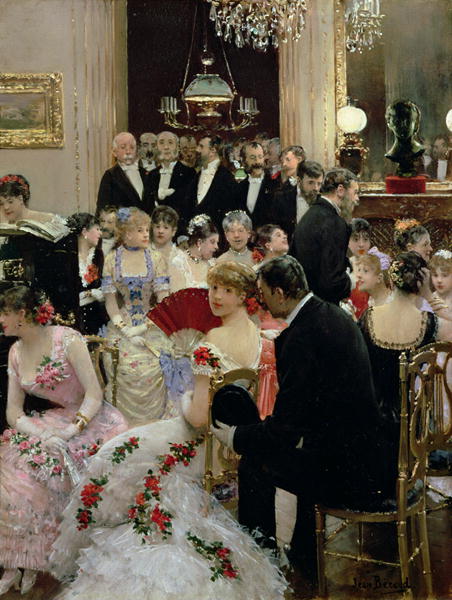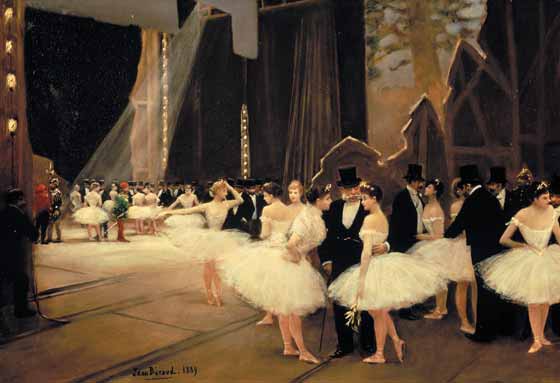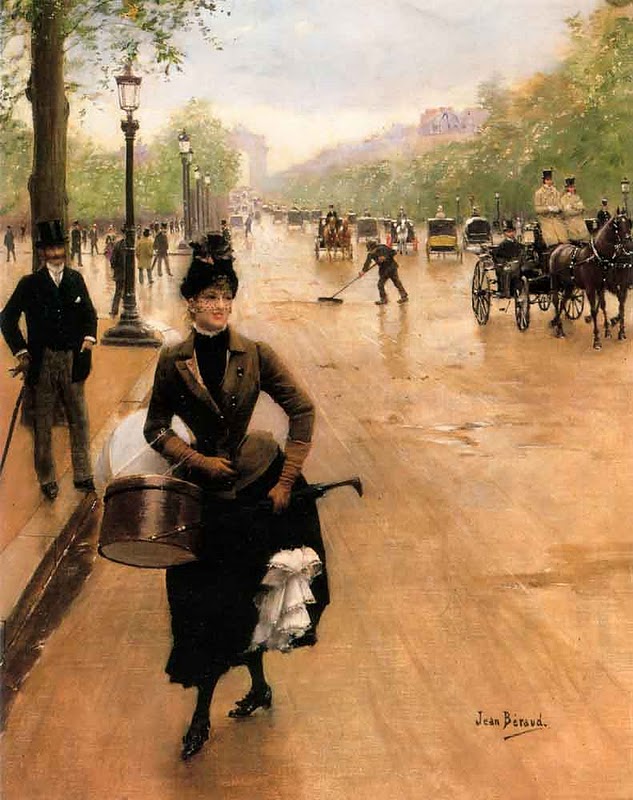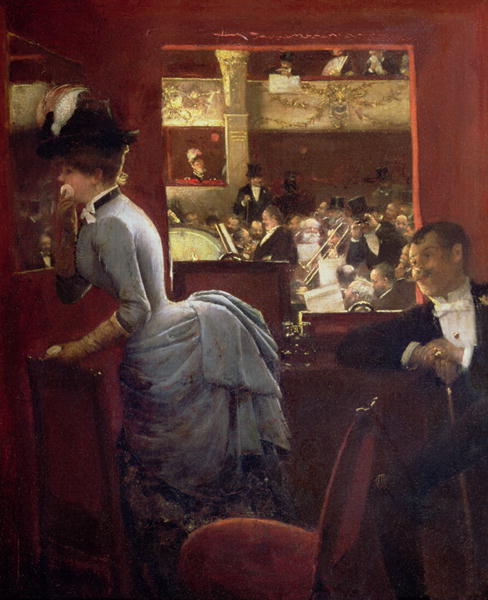In Marcel Proust’s ”Remembrance of Things Past”, there is a strong sense of familiarity making the narrator lose the sense of ecstasy he felt when the Faubourg was out of reach; that impenetrable social enclave on the right bank of the Seine. He becomes aware of the malice and foolishness that exclusiveness conceals. He test the walls of the temple, and they give a hollow sound. Much of the exquisite politeness is calculated; ” The ladies of the Faubourg built up a credit of amiability in anticipation of the dinner and garden party where they will not invite you, and are particularly nice in prevision of the day when they will overlook you.”

''Born in St Petersburg in 1849, the son of a French Sculptor, Béraud moved to Paris to complete his law studies at the Lycée Bonaparte. Béraud exhibited his paintings at the Salon for the first time in 1872. However, he did not gain much recognition until 1876.''
The men are convinced that no greater honor exists than that of being accepted by them. Charles Swann , an outsider who has been thus honored, is by birth neither an aristocrat nor a Gentile. When the fate of Captain Dreyfus intrudes on the smugness of the Faubourg Saint-Germain, the Duc de Guermantes cannot understand how Swann, after having received a friendly reception from the Faubourg , can be sympathetic to the Jewish officer accused of treason.
The elegance, the refinement, the courtliness, are screens that mask unfeeling hearts. The narrator, although still awed by the faubourg’s splendor, exposes its callousness, as in the famous scene where Swann arrives at the Guermantes town house and announces that he is dying to the Duchesse, who is late for dinner. ”Whats’s that you say?, ” cried the Duchess, stopping for a moment on her way to the carriage, and raising her fine eyes, their melancholy blue clouded by uncertainty. Placed for the first time in her life by the two duties as incompatible as getting into her carriage to go out to dinner and shewing pity for a man who was about to die, she could find nothing in the code of conventions that indicated the right line to follow, and, not knowing which to choose, felt better to make a show of not believing that the latter alternative need be seriously considered, so as to follow the first, which demanded of her at the moment less effort, and thought that the best way of settling the conflict would be to deny that any existed. ‘You’re joking,’ she said to Swann”. ( Sanche de Gramont, Horizon, )

''Béraud's work was greeted with great enthusiasm and he was welcomed into Parisian society receiving many commissions for portraits from famous figures such as the Prince d'Orleans and Prince Troubetskoy. He attended many of the evening soirees arranged by the popular hostesses of the time and frequently depicted these scenes in his paintings.''
The Faubourg carries within it the seeds of decline. The narrator watches it founder, the victim of external circumstances, such as the war, as well as of its inability to defend itself against the principal cause of infiltration which is misalliances. When Robert de Saint-Loup, the Duc de Guermante’s nephew, marries Gilberte, the daughter of Odette and Swann, the Princesse de Silistrie complains that ” there is no more Faubourg, Saint-Loup is marrying a Jew’s daughter.” The narrator, returning to Paris after a long absence, fins the Faubourg no longer exclusive:”… a thousand alien elements made their way in and all homogeneity, all consistency of form and color was lost. The Faubourg Saint-Germain was like some senile dowager now, who replies only with timid smiles to the insolent servants who invade her drawing rooms,, drink her orangeade, present their mistresses to her.”
Stunning reversals have hastened the Faubourg’s decline. The Prince de Guermantes, ruined by the war, his wife dead, has married the rich Mme Verdurin, the incarnation of bourgeois pretension, whom no lady of the Faubourg, a few years earlier, would have received. The Duchesse now requents social groups much further down the social scale, and has become particularly fond of the company of actresses. The Duc has become hopelessly infatuated with Swann’s widow, Odette, who has in the meantime been married to the Baron de Forcheville.( Sanche de Gramont, Horizon)

''La Modiste Sur La Champs Elysees He exhibited with the Society of French Watercolorists at the 1889 World's Fair in Paris. He painted many scenes of Parisian daily life during the Belle Époque in a style that stands in between the academic art of the Salon and that of the Impressionists.''
Thus Odette, who starts out a complete courtesan, becomes in the end the wife of one member of the Faubourg and the mistress of another. The dodering Duc de Guermantes is so taken with Odette that he accepts in her home the presence of people he would in the past have disdained. Social boundaries have crumbled, and Odette shows off her relic of the Faubourg like a collector showing an antique. ”All that seemed to be forever fixed is constantly being refashioned…” the narrator remarks.
Running parallel to the decline of the Faubourg as a social bastion is the decline of the narrator’s friends caused by advancing years, and the transformation of the city owing to the war. The narrator sees men and women he had known young now resembling phantoms, imprisoned in the thousand bonds of the past, age having marked their faces the way geologic change marks the surface of the earth. The men were now elderly white haired hermits. Women,s faces were crumbling lie statues. Some faces seem covered by a plastic mask, others by a gauze veil. Gilberte, the narrator’s first love, has become fat lady whom he fails to recognize, and then mistakes for her mother Odette.( Sanche de Gramont, Horizon )
0242" title="proust9" src="/wp-content/uploads/2010/03/proust9.jpg" alt="Proust, back row center, with mustache, is seen amid friends, some of whom unwittingly served him as models in ''Remembrance of Things Past''" width="325" height="350" />
Proust, back row center, with mustache, is seen amid friends, some of whom unwittingly served him as models in ''Remembrance of Things Past''









 COMMENTS
COMMENTS



